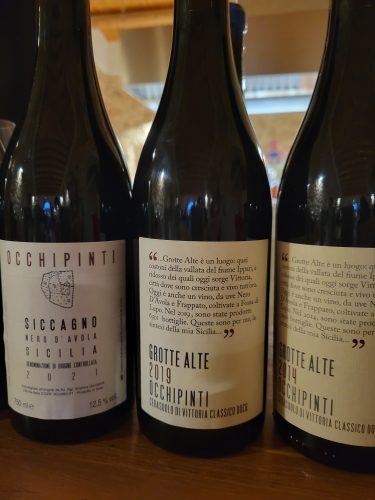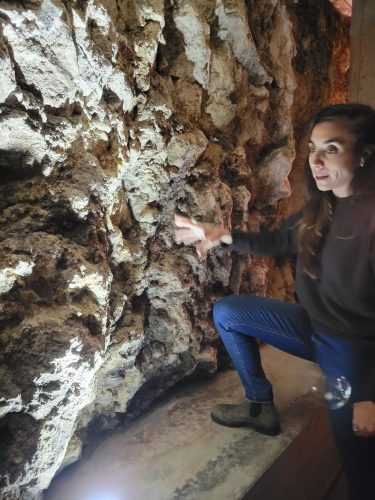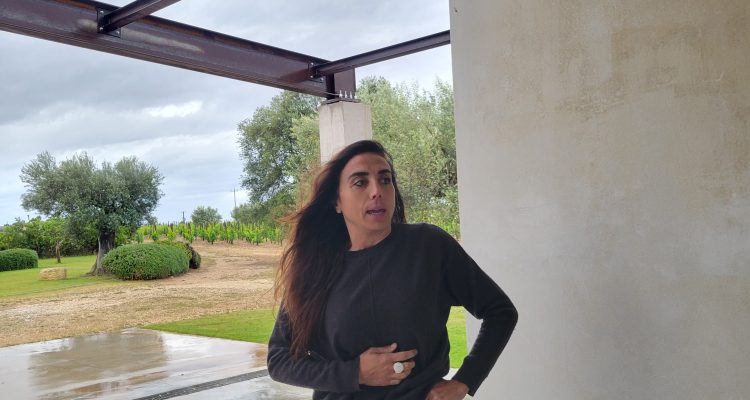It only took me a short time to find out
“When I was sixteen or seventeen I went to Vinitaly and saw a lot of happy people,” celebrated winemaker Arianna Occhipinti tells us, her audience of ten or twelve journalists, on a windy day in southern/central Sicily. Arianna credits her teen-age experience at the annual Italian wine conference with inspiring her study winemaking. Twenty years later, she has become an international wine legend.
Today, she stands confidently in her Sicilian winery, dressed in jeans and boots, her long, vibrant dark hair framing a face distinctive in its intensity. Piloting our small group through the winery, she relates that while studying in Milan for three years she made it a point to “visit a lot of wineries” which helped develop her philosophy of wine and viticulture. She also recognizes the powerful influence of her architect father Bruno, and her winemaker uncle Giusto Occhipinti of the fabled COS winery at the edge of Mt. Etna. She calls them “two active men” from whom she “received this kind of education”: teaching by their example.
Even after spending a short time in Arianna’s presence, I have the feeling she was always a force to be reckoned with, charging ahead into the wine world at a very young age. She began by investigating vineyards near her family’s home, noting those that were abandoned twenty years ago because of the low prices of grapes at that time. So she was ready to pounce when she finally found a place to buy that’s “a f***ing good terroir.”
In her winery and vineyards, she practices winegrowing and winemaking as naturally as possible. Fearlessly so. And it’s for this powerful commitment, as well as her unique wines, that she is lauded today, when she’s not yet forty years old.
Almost 100% of her vineyards are un-irrigated so the vines learn to create roots that push deep underground to seek moisture. On her land she has 40 hectares (almost 100 acres) of vines, twenty of olives (close to 50 acres), ten of wheat (25 acres), one hectare of fruit (nearly two and a half acres), and a significant vegetable garden – along with native wooded areas, Mediterranean maquis, and other indigenous flora.
“Biodiversity is the central theme,” Arianna tells us. But she candidly admits “biodiversity costs a lot” and it’s only thanks to the prices her wines command that she can maintain biodynamic and organic agriculture. This “pluri-culture” also helps her keep her agricultural employees busy throughout the year. She appreciates their sticking with her because it’s almost impossible to find new people to work with. Every time she has to hire someone, she must find a person who shares her vision and is also able to communicate it in their work. And then “I train them all the time,” she says, starting them with a three-week course on viticultural theory and practice.
She also educates the consumers and hospitality workers who serve her wines, wherever they are. For example, she packs two bottles of different single-vineyard wines with a descriptive card to educate the restaurateurs she supplies, so they don’t have to blindly choose a case of one or the other, so they really understand what they will be buying.
To produce the wines she says, “I just use what I have. I like to make wine that changes vintage to vintage.” Arianna’s harvest is customized according to each vintage, but typically begins at the end of August, and doesn’t finish until the first week of October in certain frappato vineyards. Climate change during the last few years has created tough situations in terms of weather and insects in the vineyards; she and other winemakers have formed a WhatsApp group to try out various natural substances to combat vine and grape issues.
She prefers spontaneous fermentation with natural yeasts, which must be followed carefully. She uses whole bunch fermentation for about 80% of her grapes “to recognize the terroir” and mainly stays away from carbonic maceration. More now than she did ten years ago, Arianna feels that the term organic represents what she does, and she has found that a low pH is critical.
She, herself is very active in the vineyards as well as in the winery – on a tractor, on foot, whatever. She enjoys spending a lot of her time outside, looking after the grapes, olives, vegetables – and, seemingly, every aspect of her land.
A decade ago, when she built her own winery after renting for ten years, she decided on (mostly unlined) concrete tanks for nearly all the fermentation. Concrete was popular in winemaking until the late 20th century, when it became thought of as old fashioned and unromantic. However, concrete vats have been making a comeback with winemakers who want less external influence than conventional wooden barrels, on their wines. Arianna also uses some large (more neutral) vats, and has small tanks to ferment her “contrada” (single vineyard-style) wines separately.
BARREL SAMPLES
Descending into the cellar, we were thrilled when Arianna offered us barrel samples. Those we tasted included the 2022 and the 2021 Santa Margherita grillo, with grapes destemmed after 20 hours in a temperature controlled environment. The grapes were pressed cold then fermented half in large, oval barrels and half in concrete tank. The 2021 is leaner, the 2022 lusher.
The winery’s location near Vittoria traditionally means red wine production, and we also sampled several of Arianna’s finished contrada wines from that area, each with distinctively different flavors and aromas. Her 2021 PT Frappato, from old vines in Vittoria, is a disease-resistant biotype grown on red sand. Underneath the sand is tufa, a porous limestone that absorbs the fall rains and releases water gradually. The 2021 FL is made from grapes in a 20-year-old vineyard, the first she planted. The grapes grow in about ten inches of brown sand with some limestone, over a layer of compact limestone with some sand. The 2021 BB is from 30-year-old vineyards, all limestone with sand and little stones on top of the compact limestone underneath.
A fifth sample, the 2021 Nero d’Avola is the only wine she makes using 100% of this grape. It comes mainly from bush vines in limestone with a bit of red sand on top. After the grapes are macerated for two and half weeks, the wine is aged for two years in Austrian oak barrels, and Arianna calls it “austere.” The wine itself is bright, fruity, with apparently light tannins and acidity but there are more than enough of these elements to give it definite ageing potential.
Then Arianna took us further back in time with a couple older samples. The 2019 Cerasuolo di Vittoria is made with 50-50 frappato and nero d’avola, which has some reduction at this point. The 2014 of the same blend is saltier, with plenty of acidity, lightly touched by balsamic.
The cellar seemed pretty full, and Arianna confessed, “Every ten years I build something.” This time, it’s a new winery and ageing property. And she has also acquired another ten hectares of vineyards. She does not plan any increases in production. “Unless I find something interesting,” she qualifies. She is always making small improvements, but mainly, she says, “I want to keep my identity in terms of terroir and winemaking.”

DINNER AND WINES
Arianna’s wines are often given names which are only explicable if you live in Sicily. Her SP68 line refers to the small highway which was an ancient Greek wine road when Sicily was known for its production of wheat, wine and some olive oil. Two SP68 wines were paired with initial courses: crostini with fava bean puree topped with bottarga, and a carpaccio of swordfish in a cabbage water sauce (which tastes a whole lot better than it sounds); and Norma-style ravioli consisting of layers of eggplant, pasta and tomato sauce, topped not with Parmesan but with aged, salted ricotta.
A 2022 Il Frappato went beautifully with mackerel filet, ribbons of swiss chard, a sauce of greens, and olive crumbs. As did the 2010 BB, with a complementary iodine aroma, and an overall youthful feel with flavors of oak (vinified half in Slavonian oak, half in stainless steel) and fruit that is just starting to segue into secondary flavors and aromas.
A wine highlight of the night for me was the 2010 SP68 which began with a huge floral-rose aroma arising from the glass. Made with albanello and zibibbo, this orange-brown wine was medium bodied, not sweet but incredibly aromatic. It accompanied a lovely dessert of pistachio mousse drizzled with plenty of chocolate, and topped with crumbled nuts.
CODA
After spending the afternoon with dynamic Arianna, and meeting her vigorous father along with other energetic winery personnel, we adjourned for dinner at the nearby restaurant at Baglio Occhipinti. This small luxury hotel is run by Arianna’s sister Fausta who returned from working in Paris to take up her part in the Occhipinti family business and estate. In addition to a number of fine rooms and suites, the property boasts a pool, vegetable garden and citrus orchard. Fausto also offers local craft classes, cooking classes with her chefs, and Italian lessons with her father Bruno, which he enjoys as much as his students.
During the excellent meal, I was fortunately seated next to Fausta and was able to observe firsthand her smooth management of the dining room while we chatted. Before we departed, I asked Fausta: When the two sisters were little, what did she think Arianna would become? “A tractor driver,” she answered honestly. After a beat, she concluded with surprise, “I guess that’s true!”


